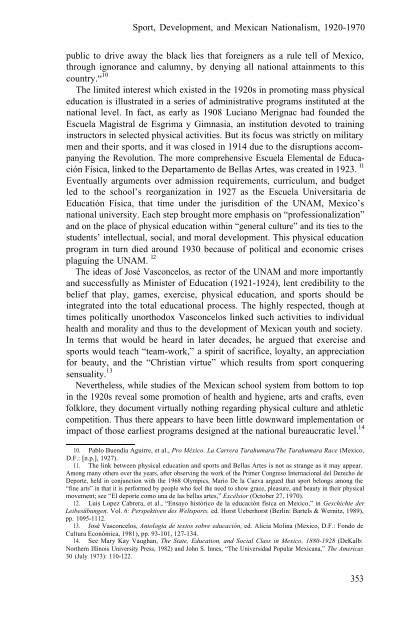Sport Development and Mexican Nationalism - LA84 Foundation
Sport Development and Mexican Nationalism - LA84 Foundation
Sport Development and Mexican Nationalism - LA84 Foundation
You also want an ePaper? Increase the reach of your titles
YUMPU automatically turns print PDFs into web optimized ePapers that Google loves.
<strong>Sport</strong>, <strong>Development</strong>, <strong>and</strong> <strong>Mexican</strong> <strong>Nationalism</strong>, 1920-1970<br />
public to drive away the black lies that foreigners as a rule tell of Mexico,<br />
through ignorance <strong>and</strong> calumny, by denying all national attainments to this<br />
country.“ 10<br />
The limited interest which existed in the 1920s in promoting mass physical<br />
education is illustrated in a series of administrative programs instituted at the<br />
national level. In fact, as early as 1908 Luciano Merignac had founded the<br />
Escuela Magistral de Esgrima y Gimnasia, an institution devoted to training<br />
instructors in selected physical activities. But its focus was strictly on military<br />
men <strong>and</strong> their sports, <strong>and</strong> it was closed in 1914 due to the disruptions accompanying<br />
the Revolution. The more comprehensive Escuela Elemental de Educación<br />
Física, linked to the Departamento de Bellas Artes, was created in 1923. l1<br />
Eventually arguments over admission requirements, curriculum, <strong>and</strong> budget<br />
led to the school’s reorganization in 1927 as the Escuela Universitaria de<br />
Educatión Física, that time under the jurisdition of the UNAM, Mexico’s<br />
national university. Each step brought more emphasis on “professionalization”<br />
<strong>and</strong> on the place of physical education within “general culture” <strong>and</strong> its ties to the<br />
students’ intellectual, social, <strong>and</strong> moral development. This physical education<br />
program in turn died around 1930 because of political <strong>and</strong> economic crises<br />
plaguing the UNAM. l2<br />
The ideas of José Vasconcelos, as rector of the UNAM <strong>and</strong> more importantly<br />
<strong>and</strong> successfully as Minister of Education (1921-1924), lent credibility to the<br />
belief that play, games, exercise, physical education, <strong>and</strong> sports should be<br />
integrated into the total educational process. The highly respected, though at<br />
times politically unorthodox Vasconcelos linked such activities to individual<br />
health <strong>and</strong> morality <strong>and</strong> thus to the development of <strong>Mexican</strong> youth <strong>and</strong> society.<br />
In terms that would be heard in later decades, he argued that exercise <strong>and</strong><br />
sports would teach “team-work,” a spirit of sacrifice, loyalty, an appreciation<br />
for beauty, <strong>and</strong> the “Christian virtue” which results from sport conquering<br />
sensuality. 13<br />
Nevertheless, while studies of the <strong>Mexican</strong> school system from bottom to top<br />
in the 1920s reveal some promotion of health <strong>and</strong> hygiene, arts <strong>and</strong> crafts, even<br />
folklore, they document virtually nothing regarding physical culture <strong>and</strong> athletic<br />
competition. Thus there appears to have been little downward implementation or<br />
impact of those earliest programs designed at the national bureaucratic level. 14<br />
10. Pablo Buendía Aguirre, et al., Pro México. La Carrera Tarahumara/The Tarahumara Race (Mexico,<br />
D.F.: [n.p.], 1927).<br />
11. The link between physical education <strong>and</strong> sports <strong>and</strong> Bellas Artes is not as strange as it may appear.<br />
Among many others over the years, after observing the work of the Primer Congreso Internacional del Derecho de<br />
Deporte, held in conjunction with the 1968 Olympics, Mario De la Cueva argued that sport belongs among the<br />
“fine arts” in that it is performed by people who feel the need to show grace, pleasure, <strong>and</strong> beauty in their physical<br />
movement; see “El deporte como una de las bellas artes,” Excélsior (October 27, 1970).<br />
12. Luis Lopez Cabrera, et al., “Ensayo histórico de la educación física en Mexico,” in Geschichte der<br />
Leibesübungen, Vol. 6: Perspektiven des Weltsports, ed. Horst Ueberhorst (Berlin: Bartels & Wernitz, 1989),<br />
pp. 1095-1112.<br />
13. José Vasconcelos, Antología de textos sobre educación, ed. Alicia Molina (Mexico, D.F.: Fondo de<br />
Cultura Económica, 1981), pp. 93-101, 127-134.<br />
14. See Mary Kay Vaughan, The State, Education, <strong>and</strong> Social Class in Mexico, 1880-1928 (DeKalb:<br />
Northern Illinois University Press, 1982) <strong>and</strong> John S. Innes, “The Universidad Popular <strong>Mexican</strong>a,” The Americas<br />
30 (July 1973): 110-122.<br />
353
















